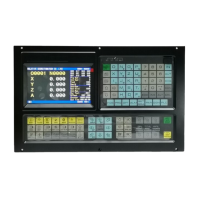TOMATECH AUTOMATION
� Sequence (defined by standard PLC program)
The sequence of tailstock is shown in Fig. 2-56:
Tailstock advancing (DOTWJ) and retracting(DOTWS) are both inactive when power on;
when
the tailstock input (DITW) is active for the 1st time, tailstock advancing is active; when it is
active for
the 2nd time, tailstock retracting is active, so the DOTWJ/ DOTWS signal interlock is
output
alternatively, i.e. The output changes each time the DITW signal is active. If M10 is
executed, DOTWJ
(CN62.34) outputs 0V and tailstock advances; if M11 is executed, DOTWS (CN62.35)
outputs 0V and
tailstock retracts.
DITW signal is inactive as spindle is running. If M11 is executed, alarm will be issued, and
its
output are held on. And DOTWS, DOTWJ outputs are held on at CNC reset or emergency
stop.
2.8.16 Low pressure detection
� Relevant signal (defined by standard PLC program)
PRES: Low pressure alarm detection signal, sharing a common interface with TCP.
Input signal DITW
Output signal DOTWJ
Output signal DOTWS
Fig. 2-56 Tailstock sequence
362
Ⅲ Connection
� Signal diagnosis
Signal PRES
Diagnosis address X0.6
Interface pin CN61.7
� Control parameters
State parameter
K 1 4 SPB3 PB3
PB3 =0: Low pressure detection inactive.
=1: Low pressure detection active.
SPB3 =0: Low pressure alarm issued when PRES is connected with +24V.
=1: Low pressure alarm issued when PRES is connected with 0V.
PLC data parameter
D T 0 2 PEALMTIM
PEALMTIM: Waiting time before low pressure alarm(0~60000ms)
� Function description
①When PB3=1 and SPB3=0, PRES is connected to +24V, which is confirmed to be low
pressure

